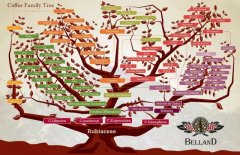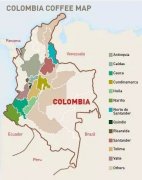Description of flavor and taste of Colombian coffee beans and their development history planting requirements and grades of raw beans
The History of Colombian Coffee
As we all know, Colombian coffee is widely used in a wide range of fields, which can be used not only for blending coffee but also for individual coffee, as well as for alcohol thickness pressure pots. It is very suitable for the needs of the public. So is everyone curious about the development history of such a variety of coffee beans? Today, let's learn how Colombian coffee developed with the editor.
Colombia's coffee-producing area is the best in the middle, with two rainy seasons each year, April-May and September-December. The central mountains belong to volcanic ash soil, which has a strong acidity, so the coffee produced is rich in fruit acid and rich aroma. The three most famous producing areas are Medellin, Armenia and Manizalez, which we call "MAM".
Part of the soil in the middle is sedimentary rock soil, where coffee is higher in alcohol and lower in acidity. The southern soil is also mostly volcanic ash soil, the planting height is the highest, the main harvest season is in the first half of the year, to "that exquisite coffee (Narino)" as the boutique. two
Colombian coffee is generally characterized by full and neat bean shape, rich and thick aroma, some with fruit aroma, some with chocolate aroma, depending on where the specific species are, strong acidity in taste, softness and smoothness, and delicious taste, with Supremo as the best.
Columbia Coffee Raw Bean grading Standard:
Excelso export grade is the most widely used export standard grade of FNC at present, and it is also the best export grade of Colombian raw beans.
How do you classify Colombian coffee beans?
In a nutshell, the ones currently in circulation in the Chinese market are roughly divided into three categories:
Excelso UGQ 1260 (1.5%): the full name of UGQ is Usual Good Quality (usually high quality). The size of raw beans is more than 14 mesh, 1.5% of raw beans can be allowed between 12 mesh and 14 mesh, but it must be more than 12 mesh, and more than 50% of them are more than 15 mesh.
Excelso EP 1260 (10%): the full name of EP is European Preparation (European customization). The size of raw beans is more than 15 mesh, and 10% of raw beans are allowed to be less than 15 mesh, but must be more than 14 mesh. Excelso Supremo 1260 (5%): the size of raw beans is more than 17 mesh. 5% raw beans are allowed to be less than 17 mesh, but must be more than 14 mesh.
Of course, in addition, Colombia has more than 16 orders called Extra, larger than Supremo more than 18 mesh called Premium, raw beans almost all uniform size in 15 mesh called Minama and so on.
Next, let's introduce two Colombian beans from the front street coffee.

Columbia Flower Moon Night
Producing area: Huilan
Manor: Esquito Gardin
Altitude: 1800 m
Treatment: anaerobic solarization

Columbia Rose Valley
Producing area: Santander
Manor: big tree
Treatment: double anaerobic enzyme washing
Both belong to Colombia, but the two beans belong to different producing areas. Rose Valley comes from the Uncle Manor in Santander. Huayue Night comes from Estogatine Farm in Huilan area. Rose Valley tastes more like a glass of juice, grapes and strawberries with the scent of flowers. Floral and moonlit nights are more even, with floral strawberries mixed with black cocoa, cream and a sense of fermentation.
Important Notice :
前街咖啡 FrontStreet Coffee has moved to new addredd:
FrontStreet Coffee Address: 315,Donghua East Road,GuangZhou
Tel:020 38364473
- Prev

What are the varieties of coffee what's the difference between Arabica and Robusta Liberian coffee
Coffee beans grow boutique coffee from the niche market in the past to the public gradually, attracting many coffee lovers. The situation of coffee beans is complicated. I believe that many coffee rookies do not know what to do in the face of complicated coffee varieties. Qianjie Coffee will briefly introduce the kind of coffee to you. In plant taxonomy, coffee belongs to the family of Rubiaceae, and there are at least one hundred coffees under it.
- Next

Description of cherry blossom flavor and taste of Paradise Manor in Columbia Coffee Bean producing area
Colombia has good mountains and water, rich landforms, groups of volcanoes, soil and rain, making it an excellent place to grow coffee. The main commercial beans in the central part are the bulk commercial coffee producing areas of Colombia, commonly known as [MAM] M refers to Medillin Medin, the capital of Antioquia province, A refers to Menia Armenia, the capital of Kindio province, and the last M refers to Calda province.
Related
- Detailed explanation of Jadeite planting Land in Panamanian Jadeite Manor introduction to the grading system of Jadeite competitive bidding, Red bid, Green bid and Rose Summer
- Story of Coffee planting in Brenka region of Costa Rica Stonehenge Manor anaerobic heavy honey treatment of flavor mouth
- What's on the barrel of Blue Mountain Coffee beans?
- Can American coffee also pull flowers? How to use hot American style to pull out a good-looking pattern?
- Can you make a cold extract with coffee beans? What is the right proportion for cold-extracted coffee formula?
- Indonesian PWN Gold Mandrine Coffee Origin Features Flavor How to Chong? Mandolin coffee is American.
- A brief introduction to the flavor characteristics of Brazilian yellow bourbon coffee beans
- What is the effect of different water quality on the flavor of cold-extracted coffee? What kind of water is best for brewing coffee?
- Why do you think of Rose Summer whenever you mention Panamanian coffee?
- Introduction to the characteristics of authentic blue mountain coffee bean producing areas? What is the CIB Coffee Authority in Jamaica?

